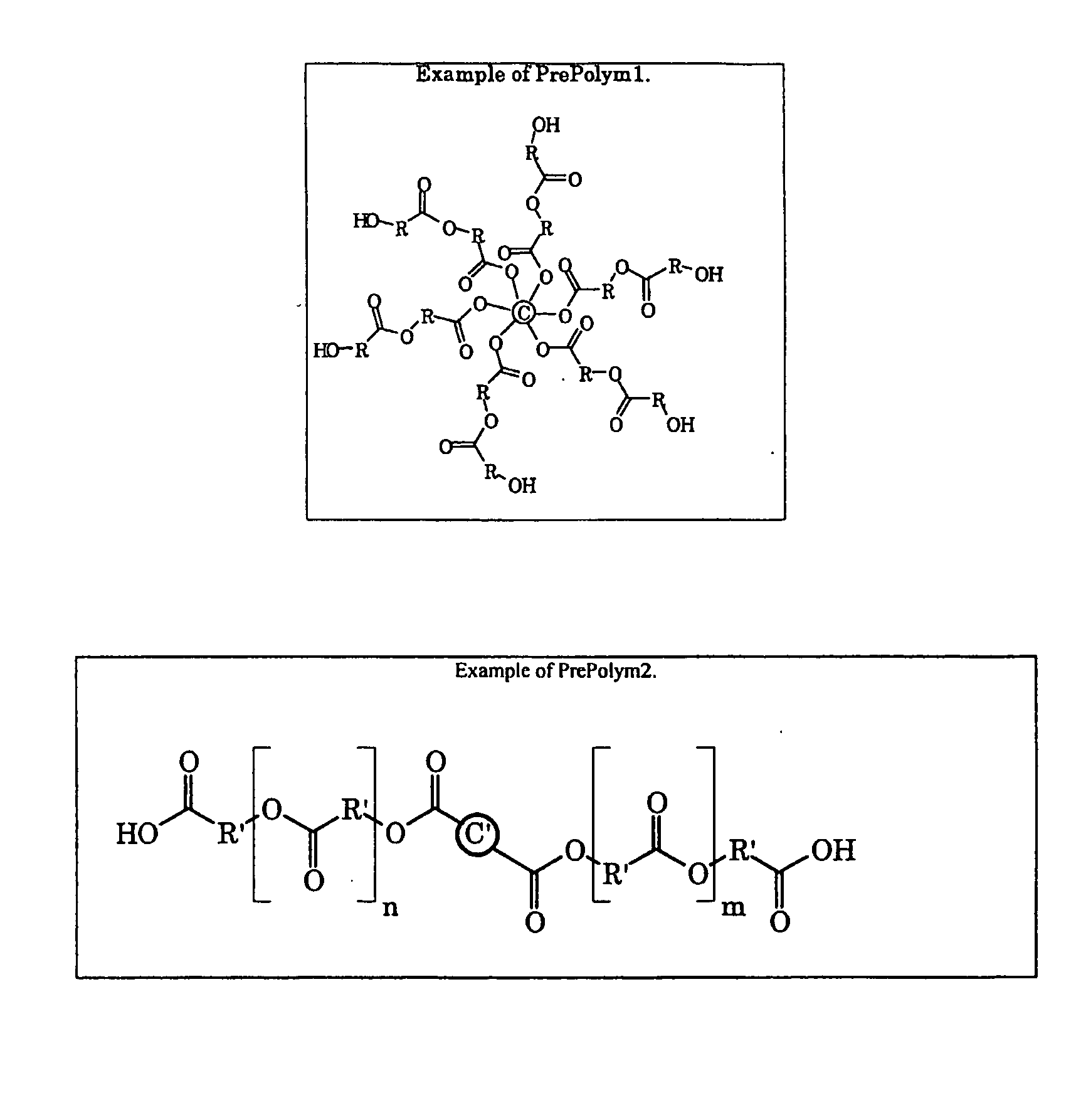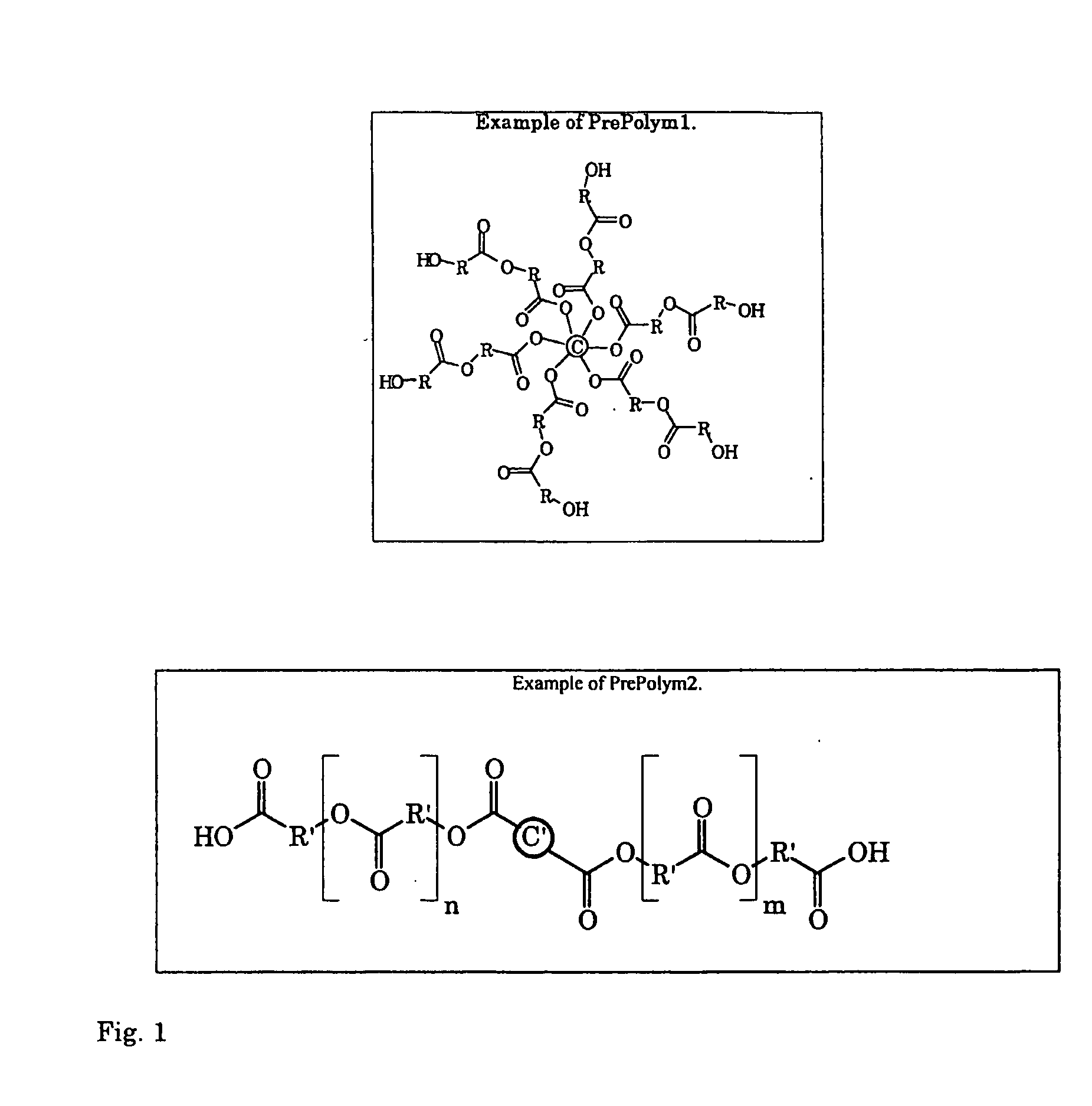Hyperbranched Polymers
a polymer and hyperbranched technology, applied in the field of hyperbranched polymers, can solve the problems of inability to prepare a high molar mass polymer, negative environmental impact, and inability to direct dehydration condensation reaction, and achieve the effect of high yield
- Summary
- Abstract
- Description
- Claims
- Application Information
AI Technical Summary
Benefits of technology
Problems solved by technology
Method used
Image
Examples
example 1
Preparation of Prepolymers by Dehydration Condensation Reaction
[0056]To a round-bottomed flask, different hydroxycarboxylic acid(s) (see Table 1) containing free water, initiating compound containing carboxylic acid groups or hydroxyl groups, and 0.1 wt % of stannous 2-ethylhexanoate were charged and heated under stirring in a rotary evaporator unit under reduced pressure to remove the free water from the reaction mixture and oligomerize the hydroxycarboxylic acid. After the calculated free water was removed and some oligomerization had occurred, the rotary evaporator unit was cleaned with acetone, the pressure again lowered stepwise to the minimal pressure specified in Table 1, and the dehydration condensation reaction continued at 180° C. for the time specified in Table 1. After discontinuing the reaction, the polymerization products were cooled and stored under ambient conditions until analyzed and used for further linking-reactions. The conditions during the dehydration condensa...
example 2
Preparation of Prepolymers by Ring-Opening Polymerization
[0057]To a pre-heated (170° C.) reaction vessel, monomer, initiating compound, and 0.05 wt % of stannous 2-ethylhexanoate were charged under inert atmosphere. After the predetermined polymerization time the polymerization was discontinued, the polymer cooled and stored under ambient conditions before analyses and further linking-reactions. The prepolymer characteristics are shown in Table 2.
TABLE 2Molar mass and its distribution for prepolymersprepared by ring-opening polymerization.ExperimentInitiatingMwNo.MonomerCompound(g / mol)Mw / Mn 13 aε-caprolactonepentaerythritol10 3001.1714ε-caprolactonepentaerythritol 6 7001.4315rac-lactidephloroglucinol33 8001.6916rac-lactideinositol16 4001.3017rac-lactideDipentaerythritol21 6001.1818L,L-lactidepentaerythritol31 7001.45 19 b, cε-caprolactone / pentaerythritol10 2001.24L,L-lactide 20 c, dε-caprolactone / pentaerythritol10 5001.41L,L-lactide 21 dε-caprolactone / pentaerythritol22 6001.35r...
example 3
Build-Up in Molar Mass vs. Polymerization Time
[0058]To a round-bottomed flask, 59.95 g of the hydroxyl-terminated prepolymer from Experiment No. 5 and 12.68 g of the carboxylic acid-terminated prepolymer from Experiment No. 10 were charged and heated at 180° C. under stirring in a rotary evaporator unit. The pressure was stepwise lowered to a minimum value of 3 mbar and the dehydration condensation reaction was monitored by the build-up of weight-average molar mass as a function of polymerization time. Within 10 h a rigid poly(hydroxycarboxylic acid) having a weight-average molar mass exceeding 200,000 g / mol was obtained. FIG. 3 shows the weight-average molar mass vs. polymerization time.
PUM
| Property | Measurement | Unit |
|---|---|---|
| weight-average molar mass | aaaaa | aaaaa |
| weight-average molar mass | aaaaa | aaaaa |
| temperature | aaaaa | aaaaa |
Abstract
Description
Claims
Application Information
 Login to View More
Login to View More - R&D
- Intellectual Property
- Life Sciences
- Materials
- Tech Scout
- Unparalleled Data Quality
- Higher Quality Content
- 60% Fewer Hallucinations
Browse by: Latest US Patents, China's latest patents, Technical Efficacy Thesaurus, Application Domain, Technology Topic, Popular Technical Reports.
© 2025 PatSnap. All rights reserved.Legal|Privacy policy|Modern Slavery Act Transparency Statement|Sitemap|About US| Contact US: help@patsnap.com



